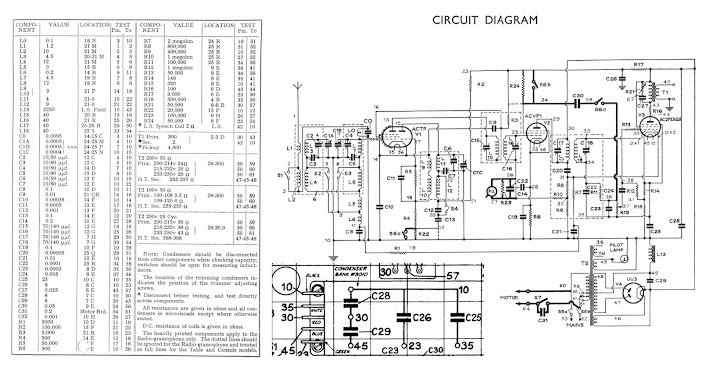Released in 1936 as A30 table top radio and the A30C, console version. This 4 valve superhetrodyne circuit with 119 Khz IF frequency, and a cabinet designed by R.G. Russell stands around 4 feet high but has quite a narrow depth to it, similar to a Grandfather clock. One of the valves is a now rare UU3 double diode rectifier, if needed a couple of silicon high voltage diodes be bridged on the valve base pins. The sound output valve is an AC2PENDD, nice power pentode with 2 diodes, one for detection of RF and the other for AGC control. It gives 10 watts of power to the 10 inch speaker, making the set sound nice, and the AGC solves the powerful signals being distorted and the weak being faint.
When I found this the previous owner in Gosport, near the Isle Of White had owned it for 50 years and cosmetically was in quite nice condition, just a water ring on top in varnish. But electrically it was quite sad. The last repair had failed and I had to pick up the pieces where that left off.
First thing I checked was the on-off switches, both read OC, I drilled a small hole in the Bakelite body and injected some cleaner fluid, that did the trick. The controls are quite unique on this set as all the knobs are held in place by a centre spindle nut and bolt, so replacement is never going to be found. To my great annoyance the volume control was reading 20 meg instead of 500K even after stripping down and cleaning. The answer was to swap the wiring to the tone control instead, the pot only needed 2 wire and one end of the volume was still connecting. |
| The inside before I started work (silver box is smoothers (paper type)) |
Next I checked the HT rails for shorts and the mains transformer for continuity all was good. Switched on, No HT around 30v, at first I thought it was the UU3 valve, but after removing the power capacitor pack the HT came back up. It's in a large tin bolted to the chassis with 5 wires coming out. Took a while to work out what-was-what as no layout for set apart from a small cut-out I found of it on line. Remember non of these are electrolytic and paper types must be fitted, at least for the one 8uF that bi-polar wired. I used 7 x 1uF's wired in parallel fitted to a printed board.
Next problem was the loudspeaker, it was reading OC on the field winding. These early speakers use 3 windings on speakers; 1 for speech coil, 1 for hum coil and 1 for field coil, the later being an electro magnet with 2.2k resistance. When I removed the wiring cover the cable had just come unsoldered. That wasn't the end of it though as when fitting the heavy speaker back in the cabinet, I dropped it and all the casting broke away from the back. 24 hours later when the glue had set, I reassembled and she worked lovely to my great surprise.
The mains cable was next, it was 2 core (red and black) rubber coated wire with cotton outer, shame to remove but it was all turning to dust inside. I added an earth wire to the chassis (as this set is isolated from the mains) making the set much safer for modern use. When I dropped the radio in my car I caught the speaker cloth on the back door latch and it made a hole in the cloth. These things happen, so I stripped it down by removing 10 tiny screws and fitted new cloth I had left over from another job.
I checked most of the screen and HT decoupling capacitors and they all checked fine, the on 'c's needed was the 4 in the silver wires capacitor pack. (3 x 8uF and 1 x 25uF) the 25uF was the sound output cathode decoupling. Internal wiring is all cloth covered tinned copper and that was all in good nick, no signs of rust or tarnish anywhere. Woodworm had attracted the veneer but not penetrated through cabinet and was historic with no signs of recent holes. |
| Chassis showing new capacitors fitted, note paper type on print board |
Now MW was giving great results, but no LW as yet, I had cleaned the 6 contacts on the band switch, but still no joy. Next I measured resistance across closed switches and found one not connecting, I used folded fine sandpaper between the connections and bingo!! worked again.
Short video to show the set working in 2021







No comments:
Post a Comment